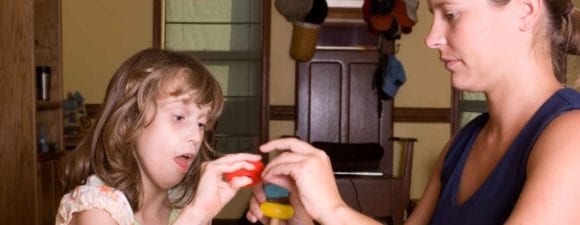The definition of autism is very narrow: autism is a developmental disorder that affects communication and interaction. Many pediatric patients did not fit well into this narrow definition so practitioners used different terms, such as Asperger’s and childhood disintegrative disorder, to create a treatment plan and for coding. Today, mental health and developmental professionals use the term ‘autism spectrum disorder’ to describe the infinite continuum of the type and severity of developmental challenges of autism.
Introduction to Autism Spectrum Disorder and the challenges of diagnosing autism
“If you’ve met one person with autism, you’ve met one person with autism.”
Dr. Stephen Shore
Many laypeople and practitioners focus on the “autism” of autism spectrum disorder, but the word “spectrum” may be the more important word in the phrase. First used scientifically in the field of optics to describe the rainbows of colors in visible light, ‘spectrum’ illustrates the tremendous diversity among patients with autism spectrum disorder.
The word ‘spectrum’ reflects the wide range of symptoms, skills, and levels of impairment that children with the disorder can present. Symptoms can result in mild impairment for some individuals and cause severe disability for others. Many children with ASD are quite smart. In fact, the intellectual ability of 46 percent of children with ASD is average or above average, according to the Centers for Disease Control and Prevention (CDC).
The term “spectrum” also reflects that fact that no two people with ASD are alike. While everyone with the disorder has trouble with communication, social skills, and flexibility of thought, each person has a unique set of characteristics that makes his ASD slightly different from another person’s disorder. Even siblings with ASD can be vastly different.
Secondary conditions and challenges of Autism Spectrum Disorder
People with ASD can have other conditions that can widen the spectrum even further. These secondary challenges of autism include:
- Speech and language difficulties
- Intellectual disability
- Sleep problems
- Attention problems
- Epilepsy
- Anxiety and depression
- Difficulties with fine and gross motor skills
ASD is the result of differences in the brain. There are many causes for these differences. Scientists do not know yet exactly what causes these differences for most people with ASD. In some cases, medical professionals can pin down the cause of ASD, such as genetic anomalies. Because of the variety of causes, the source of most cases of ASD is undetermined.
ASD does not usually result in physical effects that make people with ASD look different from others, but they may communicate, behave, interact, and learn in ways that are different from other people. The thinking, learning, and problem-solving abilities of those with ASD run the gamut from severely challenged to gifted. Some with ASD need significant help with activities of daily living while others with the condition function independently.
Prevalence of Autism Spectrum Disorder
One in every 68 children has been identified with Autism Spectrum Disorder. The disorder occurs in people of all racial, ethnic, and socioeconomic backgrounds. ASD is five times more common in boys than in girls.
Autism Spectrum Disorder tends to occur more often in those with certain genetic or chromosomal conditions. Indeed, about one in ten children with ASD also have down syndrome, tuberous sclerosis, fragile X syndrome, or other chromosomal and genetic disorders.
Fragile X syndrome (FXS) is a genetic condition that causes a range of developmental problems that include learning disabilities and cognitive impairment. FXS is the most common known single gene cause of ASD, according to The National Fragile X Foundation. Other genetic causes of ASD include deletions of chromosome 15q, tuberous sclerosis, and other rare genetic conditions
Tuberous sclerosis is a genetic disorder that causes non-malignant tumors to form in many different organs, primarily in the brain, eyes, kidneys, lungs, skin, and heart. About half of all people with tuberous sclerosis complex develop ASD, according to the Tuberous Sclerosis Alliance.
The new age of diagnosing ASD
Using DSM-IV, clinicians could diagnose patients with four separate pervasive developmental disorders:
- Autism Spectrum Disorder
- Childhood disintegrative disorder
- Asperger’s
- Pervasive developmental disorder not otherwise specified
Across various clinics and treatment areas, clinicians were not consistently applying these separate diagnoses. DSM-5 provides a new, accurate way of diagnosing autism-related disorders.
The latest edition of the Diagnostic and Statistical Manual of Mental Disorders (DSM-5) no longer includes Asperger’s syndrome as a separate diagnosis. Instead, it includes the characteristics of Asperger’s syndrome within the broader category of the autism spectrum. Patients diagnosed with any of the four pervasive developmental disorders should still meet the criteria for ASD in DSM-5.
The DSM does not outline treatment for ASD, but it does recognize that determining an accurate diagnosis is the practitioner’s first step in creating a treatment plan.
Recognizing autism through autism training
Because ASD can present itself anywhere within its wide spectrum of symptoms and severity, recognizing autism can be challenging. No blood or imaging tests exist for this disorder, leaving clinicians to rely on only their own observations of behavior and development. Diagnosticians consider detailed information gathered from caregivers, careful observation, and standardized developmental screening and comprehensive diagnostic evaluation tools.
An experienced professional can make a reliable diagnosis by the time the patient is two years old, but, because of the wide spectrum of ASD, many children with ASD do not receive a diagnosis until they are much older. This means many children are not getting the early treatment they need for the various challenges of autism.
Autism training helps clinicians recognize signs of ASD and suggest treatment courses that address the spectrum of ASD. Autism training modules focus on specific ‘colors’ that fall within the spectrum of autism disorders.



